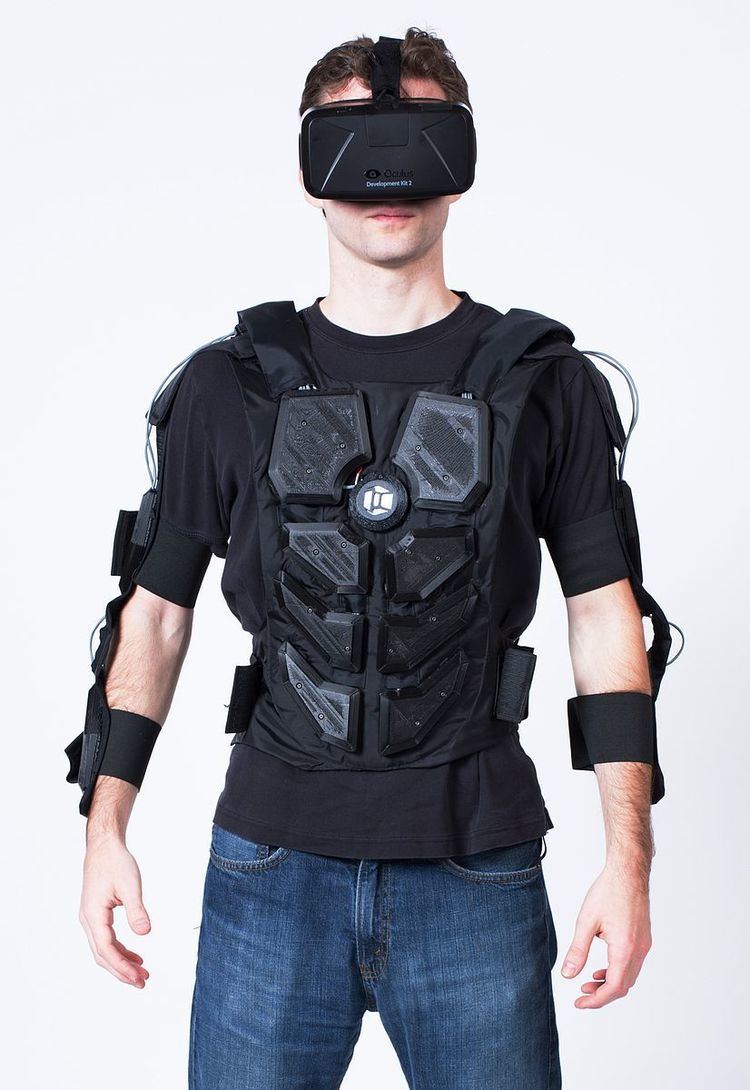 | ||
A haptic suit (also known as tactile suit, gaming suit or haptic vest) is a wearable device that provides haptic feedback to the body.
Contents
Aura Interactor (1994)
In 1994 Aura Systems launched the Interactor Vest, conceived by Aura's VP of Audio and Video Technologies, Larry Shultz to feel sound from video games and TV shows. The Interactor was a wearable force-feedback device that monitors an audio signal and uses Aura's patented electromagnetic actuator technology to convert bass sound waves into vibrations that can represent such actions as a punch or kick. The Interactor vest plugs into the audio output of a stereo, TV, or VCR and the user is provided with controls that allow for adjusting of the intensity of vibration and filtering out of high frequency sounds. The Interactor Vest is worn over the upper torso and the audio signal is reproduced through a speaker embedded in the vest. After selling 400,000 of its Interactor Vest, in Toys R Us and other electronics stores, Aura began shipping the Interactor Cushion, a device which operates like the Vest but instead of being worn, it's placed against a seat back and the user must lean against it. Both the Vest and the Cushion were launched with a price tag of $99.
3RD Space Vest (2007)
In November 2007, TNGames released the 3RD Space Vest. The vest uses eight trademarked "contact points" that simulate gunfire, body slams or G-forces associated with race car driving. It is unique because unlike traditional force feedback accessories, the vest is directional, so that action taking place outside the player's field of view can also be felt. A player hit by gunfire from behind will actually feel the shot in his back while he may not be otherwise aware of this using standard visual display cues. Currently, players have three ways to use the vest. Playing games with Direct Integration, such as TN Games' own 3rd Space Incursion, using the 3rd space game drivers whilst playing a game (drivers currently in Beta 2), or installing specially made mods for a game. As of current, the vest works with: Call of Duty 2: 3rd Space Edition, 3rd Space Incursion, Half-Life 2: Episodes 1 & 2, Crysis, Enemy Territory: Quake Wars, Clive Barker's Jericho, Unreal Tournament 3, F.E.A.R., Medal of Honor: Airborne, Quake 4 and Doom 3.
Tactile Gaming Vest (2010)
Demonstrated at Haptics Symposium 2010, the Tactile Gaming Vest (TGV) is a haptic feedback device designed to increase the immersiveness of first- and third-person shooter games and was developed by Saurabh Palan and his team from the Haptics Lab at the University of Pennsylvania. The vest can simulate gunshots, slashing and blood flow sensations. Other sensations, such as punch/kick, body blows, and surrounding environment (temperature, impacts due to artilleries and ammunitions) are also being developed.
ARAIG (2013)
On May 31, 2013, a Kickstarter campaign was launched to raise funds for the development of ARAIG (As Real As It Gets), a force-feedback and electrical muscle stimulation wearable device for use in video games. It features 16 points of feedback on the front, 16 on the back and 8 on each side. The Kickstarter campaign failed, as it only raised $126,625 of its $900,000 goal.
KOR-FX (2014)
The KOR-FX Gaming Vest uses award-winning 4DFX technology that transforms the audio coming from your games or media into pinpointed high-definition haptic (tactile) feedback.This project was funded on Kickstarter in 2014.
Teslasuit (2015)
Teslasuit is a full body haptic feedback platform for gaming and Virtual Reality. The technology is based on neuro-muscular stimulation that is widely used in electro-therapy, medicine and professional sport. Teslasuit incorporates a mesh of sensors that could deliver wide range of sensations such as touch, wind, water, heat, cold as well as the force with mild electric pulses. It can also collect data from the body for real time motion tracking. Teslasuit DK1 for early adopters is expected to be released in 2016.
HAPTIKA (2015)
HAPTIKA is developing full body wearable haptic feedback gadgets with motion capturing and temperature sensation features. HAPTIKA feedback vest has been commercialize in March 2016 and they are expecting to commercialize their full body haptic feedback system in July 2016.
Rapture (2016)
The Rapture haptic vest is under development for use in The VOID virtual reality entertainment centers. It is based on vibration motors and transducers.
NullSpace VR (2016)
NullSpace VR develops a full upper-body haptic feedback suit and gloves with stand-alone tracking for virtual reality. A total of 32 haptic feedback pads are placed around the body with 117 built-in haptic effects. The Developer SDK is currently available for developers to create their own "haptic animations".
AxonVR (2016)
AxonVR is developing a full body haptic feedback suit based on miniature hydraulic actuators
